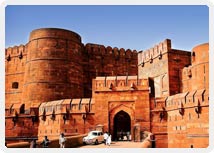+91 858 886 6045
Agra Attractions
The Taj MahalItmad-ud-daulahAgra FortSikandraFatehpur SikriMumtaz MahalTaj MahotsavChini - Ka - RauzaMariyam TombRam BaghThe Octagonal TowerDayal Bagh TempleBuland DarwazaShopping & CuisineAgra Fort

The Agra Fort also as the Red Fort was built by Akbar in 1565. It is the red sandstone fort located about 2.5 km northwest of the Taj Mahal. This is one of the most important forts in India where the great Mughals emperor like Humayun, Akbar, Jehangir, Shah Jahan and Aurangzeb lived and governed his empire.
This monumental building is known for its exceptional design and decorations which enthrall tourists during their Agra Fort Tour. It is one of the important and robustly built strongholds of the Mughals renowned for its number of richly decorated buildings encompassing the imposing Mughal style of art and architecture. The fort spread over 94 sq. km and its semi-circular design is surrounded by a 21.4 m high fortification wall. Double ramparts have been provided here with broad massive circular bastions at regular intervals.
Agra Fort is among the finest examples of the Indo Islamic architectural fusion. The fort can be accessed through four gates namely Delhi Gate, Lahore Gate and Amar Singh Gate. But now the entrance to the fort is only through the Amar Singh Gate. Agra Fort is an astounding structure comprising of sprawling palaces, royal private rooms, harems, magnificent towers, bastions, ramparts, and awe-inspiring gateways.
Some of the well-known monumental structures of this fort are:
Jahangir Mahal
This double storied palace was built by Akbar as the royal women’s quarters and the only building that survives among the original palace buildings. The architectural design of this palace reflects a Hindu influence with protruding balconies and domed chhatries. The palace is simple in its outlook and is built out of sandstone. The most important feature of this edifice is its ornamental stone brackets that support the beams. Jahangir has carved ornamental Persian verses along the outer rim of this palace which heightens its ornamental beauty.
Diwan-e-Khas
Etymologically Diwan-e-Khas is a Persian word which means ‘The Hall of Private Audience’. The hall was used for the private meetings by emperors. This building is famous for its façades as well as intricate design. The marble pillars of this building are inlaid with semi-precious stones in delightful floral patterns. It was here the famous peacock throne was kept before being shifted to Delhi by Aurangzeb and finally carried away to Iran.
Diwan-e-Aam
Divan-e-Aam was the ‘Hall of Public Audience’ constructed by Shahjahan. At this building the Emperor used to met officials and commoners and hear their petitions. This hall was piereced with Jallis to facilitatae royal female members to see the court proceedings. A The prominent structures of this building are arched covered with white lime polish, triple arched royal canopy with lavish pietra dura ornamentation and splendid ‘Jaalis’ on the back wall of the pavilion.
Sheesh Mahal
Sheesh Mahal was used as the harem dressing room. This palace is known for its walls inlaid with tiny mirrors that are the best specimens of the glass-mosaic decoration in India. The beauty of myriad glass pieces works and central fountain enthrall tourists during their visit to this palace.
Khass Mahal
This palace was built of marble and demonstrates distinctive Islamic-Persian features of design and decorations. It was the Shah Jahan’s sleeping room. The Mahal provides the most successful example of paintings on a white marble surface.
Musamman Burj
This is a beautiful octagonal tower with an open pavilion famous for its exquisite design above the pillars. It was here Shah Jahan lay on his deathbed, gazing at the Tajmahal.
Timings
6:00 am to 7:30 pm (Friday closed)
Fee
Rs. 970 (Foreigners)
Rs. 20 (Indians, during daytime)
Rs. 110 (Indians, during sunrise and sunset)
Tajmahal Tours
Golden Triangle India
- Golden Triangle with Corbett
- Golden Triangle with Goa
- Golden Triangle with Kathmandu
- Golden Triangle with Wildlife
- Indian Heritage Tour with Tajmahal
- Buddhist Pilgrimage with Golden Griangle Tour
- Golden Triangle Tour
- Golden Triangle Tour with Haridwar and Rishikesh
- Golden Triangle with Khajuraho Varanasi
- Golden Triangle with Kashmir
- Tajmahal with Pushkar Fair
Delhi Tourism
Jaipur Tourism
Agra Tourism
Golden Triangle Extension
- Ranthambhor National Park
- Khajuraho Tourism
- Varanasi Tourism
- Rishikesh Tourism
- Haridwar Tourism
- Corbett Wildlife Sanctuary
- Mathura Travel
- Vrindavan Travel
- Gwalior Travel
Activities to Do


Copyright © 2020, www.tajmahal-india-tours.com
Recognized by Ministry of Tourism, Government of India
National Tourism Award Winner
Powered by SOFTTIX

